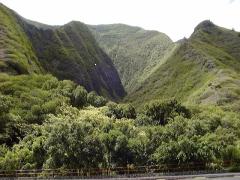Battle of Kepaniwai
| Battle of Kepaniwai | |||||||
|---|---|---|---|---|---|---|---|
| Part of Unification of Hawaii | |||||||
 ʻĪao Valley | |||||||
| |||||||
| Belligerents | |||||||
| Hawaiʻi Island | Maui | ||||||
| Commanders and leaders | |||||||
|
Kamehameha I Kekuhaupiʻo | Kalanikūpule | ||||||
| Strength | |||||||
| 1200 | 1200 | ||||||

The Battle of Kepaniwai ("Battle of the Dammed Waters of ʻĪao" or Kaʻuwaʻupali, "Battle of the Clawed Cliffs") was fought in 1790 between Hawaiʻi Island and Maui. The forces of Hawaiʻi were led by Kamehameha I, while the forces of Maui were led by Kalanikūpule. It is known as one of the most bitter battles fought in Hawaiian history.20°52′51″N 156°32′42″W / 20.88083°N 156.54500°W
While Maui's king Kahekili II was on Oʻahu, Kamehameha's war fleet landed in Kahului a few kilometers from the base of ʻĪao Valley. An army consisting of around twelve hundred skilled warriors led by Kamehameha and Kekuhaupiʻo, advanced on Kahekili's son Kalanikūpule and other Maui chiefs blocking the ʻĪao valley. The two armies were evenly matched and neither side broke after two days of fighting. On the third day Kamehameha's army was helped by the use of two cannons (named "Lopaka" and "Kalola") operated by John Young and Isaac Davis, two of Kamehameha's royal advisors. Although none of Maui's major chiefs were killed, many people died resulting in the "damming of the waters" by the corpses floating in the river. It was said that the river "ran red with the blood of the dead." Chiefess Kalola and her granddaughter Keōpūolani were able to escape west through the valley to Olowalu and north to Lahaina.[1]
After the battle, Kalola offered her 11-year-old granddaughter to Kamehameha as a future wife. Meanwhile, Keōua Kuahuʻula, the last independent chief on the Island of Hawaiʻi, who had been raiding Kamehameha's territory, quickly returned to the Big Island. This resulted in the 1790 battles of East Hawaiʻi and the 1791 battle of Kawaihae.[2]
Kahekili II resumed his rule of Maui and also acquired cannon. In 1791, Kahekili tried to invade the island of Hawaiʻi, but was defeated in a naval battle called Kepuwahaʻulaʻula. Kamehameha had to wait for the civil war that broke out in 1793 after the death of Kahekili II, and the battle of Nu'uanu to finally win control of Maui.
References
- ^ Fornander, Abraham (1880). An account of the Polynesian race; its origin and migrations, and the ancient history of the Hawaiian people to the times of Kamehameha I. Vol. II. London: Trubner & Co.
{{cite book}}: Cite has empty unknown parameter:|coauthors=(help) - ^ Keonehelelei – the falling sands Hawaii Volcanoes National Park Archaeological Inventory of the Footprints Area, Jadelyn Nakamura, 2003
